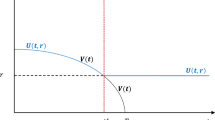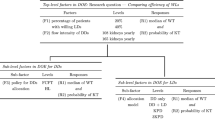Abstract
In many jurisdictions, organ allocation is done on the basis of the health status of the patient, either explicitly or implicitly. This paper presents a self-promoting priority queueing model for patient waiting times which takes into account changes in health status over time. In this model, most patients arrive as “regular” customers to the queue, but as the health of a patient degrades, their status is promoted to “priority” to reflect the increased urgency of the transplant. We model the queueing system as a level-dependent quasi-birth-and-death process, and the steady-state joint queue length distribution as well as the marginal delay distributions for each queue are computed via the use of matrix analytic techniques. The model is calibrated using liver transplantation wait-list data, provided by a regional health centre in Canada, which tracked approximately 1,100 patients over nearly 13 years. Blood-type-specific models are fit and performance measures, such as the mean and distribution of the time until transplant, are obtained and compared to empirical estimates calculated using the raw data.




Similar content being viewed by others
References
Abellán, J.J., Armero, C., Conesa, D., Pérez-Panadés, J., Martínez-Beneito, M.A., Zurriaga, O., García-Blasco, M.J., Vanaclocha, H.: Analysis of the renal transplant waiting list in the País Valencià (Spain). Stat. Med. 25, 345–358 (2006)
Barone, M., Avolio, A.W., Di Leo, A., Burra, P., Francavilla, A.: ABO blood group-related waiting list disparities in liver transplant candidates: effect of the MELD adoption. Transplantation 85, 844–849 (2008)
Bazarah, S.M., Peltekian, K.M., McAlister, V.C., Bitter-Suermann, H., MacDonald, A.S.: Utility of MELD and Child–Turcotte–Pugh scores and the Canadian waitlisting algorithm in predicting short-term survival after liver transplant. Clin. Investig. Med. 27, 162–167 (2004)
Bright, L., Taylor, P.G.: Calculating the equilibrium distribution in level dependent quasi-birth-and-death processes. Stoch. Models 11, 497–525 (1995)
Canadian Blood Services. Blood Type Facts. http://www.blood.ca/CentreApps/Internet/UW_V502_MainEngine.nsf/page/Blood+Type+Facts?OpenDocument&CloseMenu. Accessed 27 April 2013
Gaver, D.P., Jacobs, P.A., Latouche, G.: Finite birth-and-death models in randomly changing environments. Adv. Appl. Probab. 16, 715–731 (1984)
Glander, P., Budde, K., Schmidt, D., Fuller, T.F., Giessing, M., Neumayer, H.-H., Liefeldt, L.: The ‘blood group O problem’ in kidney transplantation: time to change? Nephrol. Dial. Transplant. 25, 1998–2004 (2010)
Gómez-Corral, A., Krishnamoorthy, A., Narayanan, V.C.: The impact of self-generation of priorities on multi-server queues with finite capacity. Stoch. Models 21, 427–447 (2005)
Hussey, J.C., Parameshwar, J., Banner, N.R.: Influence of blood group on mortality and waiting time before heart transplantation in the United Kingdom: implications for equity of access. J. Heart Lung Transplant. 26, 30–33 (2007)
Kalbfleisch, J.D., Prentice, R.L.: The Statistical Analysis of Failure Time Data, 2nd edn. Wiley, Hoboken (2002)
Krishnamoorthy, A., Narayanan, V.C.: On a queueing system with self generation of priorities. In: Srinivasan, S.K., Vijayakumar, A. (eds.) Stochastic Point Processes, pp. 212–217. Narosa Publishing House, Chennai (2003)
Krishnamoorthy, A., Narayanan, V.C., Deepak, T.G.: On a queueing system with self generation of priorities. Neural Parallel Sci. Comput. 13, 119–130 (2005)
Krishnamoorthy, A., Babu, S., Narayanan, V.C.: MAP/(PH/PH)/\(c\) queue with self-generation of priorities and non-preemptive service. Stoch. Anal. Appl. 26, 1250–1266 (2008)
Krishnamoorthy, A., Babu, S., Narayanan, V.C.: The MAP/(PH/PH)/1 queue with self-generation of priorities and non-preemptive service. Eur. J. Oper. Res. 195, 174–185 (2009)
Krishnamoorthy, A., Narayanan, V. C., Chakravarthy, S. R.: The impact of priority generations in a multi-priority queueing system: a simulation approach. In: Proceedings of the 2009 Winter Simulation Conference (Eds. M.D. Rossetti, R.R. Hill, B. Johansson, A. Dunkin & R.G. Ingalls), IEEE Computer Society, New York, USA, pp. 1622-1633 (2009)
Latouche, G., Ramaswami, V.: Introduction to Matrix Analytic Methods in Stochastic Modeling. ASA SIAM, Philadelphia (1999)
Lawless, J.F.: Statistical Models and Methods for Lifetime Data, 2nd edn. Wiley, Hoboken (2003)
Liefeldt, L., Budde, K., Glander, P.: Accumulation of elderly ESRD patients with blood group O on the waiting list (Letter to editors). Transpl. Int. 24, e83–e84 (2011)
Maertens, T., Walraevens, J., Bruneel, H.: Performance comparison of several priority schemes with priority jumps. Ann. Oper. Res. 162, 109–125 (2008)
Pinsky, M.A., Karlin, S.: An Introduction to Stochastic Modeling, 4th edn. Academic Press, Boston (2011)
Stanford, D.A., Renouf, E.M., McAlister, V.C.: Waiting for liver transplantation in Canada: Waitlist history 2000–04 and sensitivity analysis for the future. Health Care Manag. Sci. 11, 184–195 (2008)
Stanford, D.A., Lee, J.M., Chandok, N., McAlister, V.C.: A queueing model to address wait time inconsistency in solid-organ transplantation. Oper. Res. Health Care 3, 40–45 (2014)
Su, X., Zenios, S.: Patient choice in kidney allocation: the role of the queueing discipline. Manuf. Serv. Oper. Manag. 6, 280–301 (2004)
Syski, R.: Passage Times for Markov Chains. IOS Press, Amsterdam (1992)
Tijms, H.C.: A First Course in Stochastic Models. Wiley, Chichester (2003)
Wang, Q.: Modeling and analysis of high risk patient queues. Eur. J. Oper. Res. 155, 502–515 (2004)
Wiesner, R., Edwards, E., Freeman, R., Harper, A., Kim, R., Kamath, P., et al.: Model for end-stage liver disease (MELD) and allocation of donor livers. Gastroenterology 124, 91–96 (2003)
Zenios, S.A.: Modeling the transplant waiting list: a queueing model with reneging. Queueing Syst. 31, 239–251 (1999)
Zenios, S.A., Chertow, G.M., Wein, L.M.: Dynamic allocation of kidneys to candidates on the transplant waiting list. Oper. Res. 48, 549–569 (2000)
Acknowledgments
The authors thank the Associate Editor and the referees for their useful comments and valuable suggestions that helped improve this paper. The authors also wish to thank D. Bellhouse who suggested we consider a competing risks framework for calibrating our model. This research was supported by the Natural Sciences and Engineering Research Council of Canada through its Discovery Grants program.
Author information
Authors and Affiliations
Corresponding author
Rights and permissions
About this article
Cite this article
Drekic, S., Stanford, D.A., Woolford, D.G. et al. A model for deceased-donor transplant queue waiting times. Queueing Syst 79, 87–115 (2015). https://doi.org/10.1007/s11134-014-9417-7
Received:
Revised:
Published:
Issue Date:
DOI: https://doi.org/10.1007/s11134-014-9417-7
Keywords
- Abandonments
- Competing risks
- Estimation
- Liver transplantation
- Phase-type distribution
- Quasi-birth-and-death process
- Reneging




